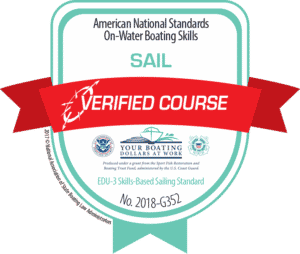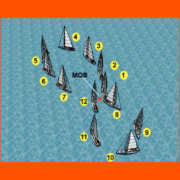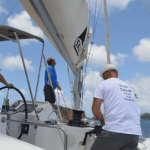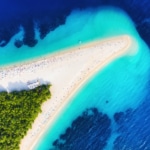Top Ten Safe Boating Tips
“A Safe Boat is a Happy Boat.”
This week is National Safe Boating Awareness Week. I’m glad they called it “awareness” week otherwise it would be just “Safe Boating Week” – does that mean unsafe boating is OK for the other 51 weeks of the year? Nope! Boating Safety is something to be aware of every day spent on the water.
Here are some top fundamentals for safe boating. “A Safe Boat Is A Happy Boat” – it’s a cliche but it makes so much sense . Mostly, we are on the water purely for one reason: recreation. And given that recreation doesn’t involve filling your lungs with water, breaking a leg, having your foot chopped off by a prop, or a wack on the head by the boom swinging across at 15 radians per second, it stands to reason that safety is our number one priority – again A Safe Boat Is A Happy Boat!
We jump into our top 10 safe boating tips with one overriding super principle and from there, the others are a natural consequence of the principle.
1. COMPETENCE
The Overriding Super Principle of Safe Boating is COMPETENCE.
Competence is a catch-all. Are YOU competent? Is competence an objective or a subjective statement? Meaning, is it measurable? What is the standard for competence? Where is the standard? How do you become a competent boater/sailor?
Our stance on competence is that it is measurable, there is a line between competent and not competent, and it is an objective quality. Let’s take a look at the definition of competence.
From a UK health and safety government site: Competence can be described as the combination of knowledge, training, skills, and experience, that a person has and their ability to apply them to perform a task safely.
From Webster: the quality or state of having sufficient knowledge, judgment, skill, and Ability
Thus competence can be measured by the following: Knowledge, Training, Skills, Experience, Ability
Standard of Competence
Background: In 2017, the US Coast Guard in conjunction with the collective States’ centralized authority (NASBLA) created the American National Standards for boating safety. They developed the standards for the various types of boating activities; human propelled boats, sailboats, powerboats, and water jet-propelled vessels.
Almost immediately, NauticEd applied for recognition under the Sailing Education Standard, EDU-3. You can see the evidence we were awarded at USCG Boating and NASBLA.
Now that there is a standard, competence in boating is measurable under the standard and NauticEd is awarded as a measuring authority under the standard.
Why is a Competence Standard Needed?
You’ve heard the saying “you don’t know what you don’t know”. A good example to explain this might be: Cardinal Marks. In the USA, Cardinal Marks are not used or taught by national bodies. You wouldn’t know they existed. A person not knowing about Cardinal Marks would not even know to ever ask what a cardinal mark is because they don’t know that they don’t know.
A standard of education takes someone through a structured quantity of learning to ensure a particular baseline of knowledge is delivered and absorbed. A standard of Competence ensures that someone has the Knowledge – Skills – Experience – Ability to be competent.
The USCG did an amazing job in creating the standard. While they did develop the necessary knowledge that should be known, they cleverly focused heavily on the on-the-water assessment. They used the educational tools of rubrics to create an assessment of skills and knowledge and abilities to adequately test the competent. Rubrics are a set of micro-tasks whereby a student can be assessed for a grade of overall competence. This allows an assessor to objectively assess at the end of the assessment period the overall competence of the student.
At NauticEd all our on-the-water sailing instructors use the American National Standards EDU-3 with the defined set of rubrics. Final grades missed by the instructors are Failed – Crew Competent – Competent Skipper – Competent Bareboat Charterer – Competent Offshore Captain.
All the above was a long way of saying, Competence is measurable and objective.
OK now onto the other 9 fundamentals of safe boating
Take NauticEd Online Sailing Theory Courseswww.nauticed.org/sailing-coursesThen Get Practical On-The-Water Training With One of Our American National Standard Qualified Instructorswww.nauticed.org/sailing-schools |
2. LIFEVESTS
You’ve heard it ad infinitum. “Put on a life vest.” So we won’t repeat it – you’re an adult. decide for yourself based on the known statistics.
But, we will address Kids. The biggest reason that kids drown is that the parent took off the kid’s life vest because the kid was complaining that it was uncomfortable. In a desperate measure to make the kid enjoy the outing on the water, off came the life vest and bye-bye lil’ johnny.
After realizing this, the US Coast Guard encouraged manufacturers to design new comfortable life vests. Guess what? Kid drownings went down significantly. Or rather think of lifevests as “The ‘Best’ lifevest is the one you wear!”
Buy a comfortable life vest for your kid so that they wear it. Before you leave the house, test to ensure the kid has not outgrown it from last season.
3. KNOW THE RULES OF GIVE-WAY
Knowing the rules is a must BUT the rules do not exonerate you from an accident if you think you are enforcing your “rights”. The rules specifically have no right of way – only give-way. And often the vessel that was NOT the give-way vessel will be found at fault because they had the opportunity to avoid the accident but did not take the appropriate action.
NauticEd offers a FREE Rules of the Nautical Road course to everyone.
4. WEATHER
In the information age, there is no excuse for being caught unaware of bad weather causing an accident. See a dark cloud in the distance? Look at the weather radar on your mobile phone and see its predicted track.
The best weather app for sailing is the Predict Wind app. It is free. NauticEd offers a free upgrade to the paid version inside our skipper courses.
Sunburn is the most common occurrence of boating-related health issues. In the excitement to get on the water, sunscreen is forgotten.
5. BOOSE AND DRUGS
If you are the vessel skipper, it is prudent to not drink. However, if you do, make a decision to go easy – at least just for today. The ramifications if someone gets hurt and you are legally over the limit or on drugs are REALLY serious and probably involve jail time even if you did not cause the accident – you are the skipper of the vessel.
Here is a nifty breathalyzer device to determine if you are legally drunk.
When doing drugs or alcohol the chemicals tend to make you feel infallible. It is why you tend to go faster – for the thrill with the false knowledge of everything is fine. Let your sober self who is watching you from the sidelines allow you to back off on the throttle. Listen to your inner sober self. You know what is proper and prudent!
6. SAFETY DEVICES AT HAND AND READY
One time at anchor in a small fishing boat, we nearly got run over by a large sailboat because the skipper and crew were sleeping on autopilot. At the last minute a gust of wind rounded up the sailboat a little – just enough to miss us. We were so dumbstruck that instead of taking action we were just caught in the headlights so to speak. We did not have an air horn at the ready. We did not have life vests out at the ready. we could easily have started the engine as it was approaching and moved in necessary – even while still on anchor. Never again after that experience will I not have the basics out and available. That was scary!
Horn, lifevest on or readily accessible, throwable flotation ring for MOB, reboarding device for MOB if you have high freeboard.
7. INSPECTION AND MAINTENANCE
Perform regular safety inspections of your boat. Imagine the ramification of even your night lights being out. A friend was nearly run down by a large high-speed ferry at night in the Solent because unbeknownst to him his red port light was out.
NauticEd has available for free a gamified badge system for training and ensuring good boater behavior. Check it out, it is a great training tool for doing the proper things that you might not know are the proper things to do.
Take a look at the checklist of sailboat maintenance items associated to the badge system.
8. KEEP A WATCH OUT
An 80 ft yacht bangs into a jetty near the exit to a harbor because the soloing captain set the autopilot and then went downstairs to answer the phone. True story!
Ferries and container ships go a lot fast than you perceive because of their size. Even a few minutes off-watch can be serious.
At night the watch crew needs to remain active with something to prevent from falling asleep. Falling asleep at night while supposedly being on-watch can lead to a complete disaster. Some people set a 15-minute egg timer just in case.
As the skipper of the boat, you not only need to watch out of the boat but continually watch your crew and boat for potentially dangerous situations. e.g. walkway hatches left wide open – sailing downwind a watch needs to be kept out for the boom auto-gybing.
Traffic coming from behind the headsail is probably one of the bigger reasons sailboats have collisions Even if you are the stand-on vessel you need to be extra diligent because of the false sense of security.
9. ELECTRONICS AND APPS
We live in the information age. Electronics are huge safety devices; use them! Some examples of available electronic tools are:
- Navigation – see Navionics
- Tides – new apps are always available – just google it.
- Boat Maintenance – we found this one but have not yet been able to test it.
- Float-plan reporting – see NauticEd iOS Tracklink App which has an embedded real-time reporting tracking link.
- Anchor Watch – See NauticEd iOS Anchor Zone App which has a GPS drift alarm.
- Weather – See Predict Wind
10. MOB
Personally, I’ve had three Man (Crew) Overboards – two men and 1 woman actually. Oh, and dozens of hats. No one is exempt from MOB. Under sail, our advice is to turn on the engines and depower/douse/furl the sails – then turn the boat around and approach the person from a downwind position. This ensures almost 100% of getting accurately back to the person. The biggest argument presented against using this method is the spinning propeller when in gear near the person. Well durh!
Actually, our recommendation is to know and practice ALL the MOB techniques applicable, both power and sail. If at sail, apply the quickest and safest method, including first considering using your engine.
There are many sources to find all the recommended actions for MOB which includes throwing a floatable ring, appointing a watch person, how to bring the person back on board, and how to do a proper approach. NauticEd details this in our Skipper course as well as our Skipper Small Keelboat Course.
Final MOB Tip: ensure that ALL of your crew if familiar with MOB techniques, protocols, and equipment. A boating irony is that the most experienced person often risks going overboard. This can be especially true in sailing when (for example) the skipper may be scrambling to the foredeck to troubleshoot or set-up lines, sails, etc….
Take NauticEd Online Sailing Theory Courseswww.nauticed.org/sailing-coursesThen Get Practical On-The-Water Training With One of Our American National Standard Qualified Instructorswww.nauticed.org/sailing-schools |








